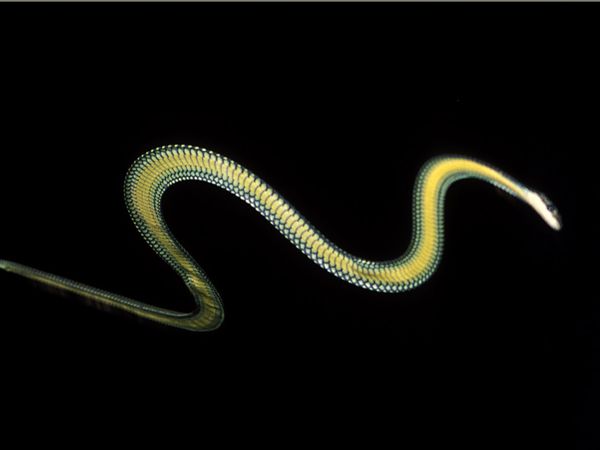Caption: Flying snakes flatten their bodies into a concave C shape to trap air as they fall. By undulating back and forth, they can actually make turns in the air. Photograph by Jake Socha
National Geographic
The image of airborne snakes may seem like the stuff of nightmares (or a certain Hollywood movie), but in the jungles of South and Southeast Asia it is reality.
Flying snake is a misnomer, since, barring a strong updraft, these animals can’t actually gain altitude. They’re gliders, using the speed of free fall and contortions of their bodies to catch the air and generate lift.
Once thought to be more parachuters than gliders, recent scientific studies have revealed intricate details about how these limbless, tube-shaped creatures turn plummeting into piloting. To prepare for take-off, a flying snake will slither to the end of a branch, and dangle in a J shape. It propels itself from the branch with the lower half of its body, forms quickly into an S, and flattens to about twice its normal width, giving its normally round body a concave C shape, which can trap air. By undulating back and forth, the snake can actually make turns. Flying snakes are technically better gliders than their more popular mammalian equivalents, the flying squirrels.
There are five recognized species of flying snake, found from western India to the Indonesian archipelago. Knowledge of their behavior in the wild is limited, but they are thought to be highly arboreal, rarely descending from the canopy. The smallest species reach about 2 feet (61 centimeters) in length and the largest grow to 4 feet (1.2 meters).
Fast Facts
Type:
Reptile
Diet:
Carnivore
Size:
Up to 4 ft (1.2 m)
Did you know?
The paradise tree snake is one of the smaller flying snakes and the best glider. It’s been known to travel up to 330 ft (100 m) in the air.
Size relative to a 6-ft (2-m) man
Their diets are variable depending on their range, but they are known to eat rodents, lizards, frogs, birds, and bats. They are mildly venomous snakes, but their tiny, fixed rear fangs make them harmless to humans.
Scientists don’t know how often or exactly why flying snakes fly, but it’s likely they use their aerobatics to escape predators, to move from tree to tree without having to descend to the forest floor, and possibly even to hunt prey.
One species, the twin-barred tree snake, is thought to be rare in its range, but flying snakes are otherwise quite abundant and have no special conservation status.








Add a comment